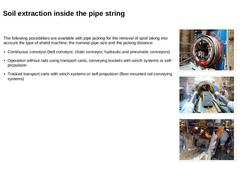
|
The following possibilities are available with pipe jacking for the removal of spoil taking into account the type of shield machine, the nominal pipe size and the jacking distance: -
Continuous conveyor (belt conveyor, chain conveyor, hydraulic and pneumatic conveyors)
-
Operation without rails using transport carts, conveying buckets with winch systems or self-propulsion
-
Tracked transport carts with winch systems or self-propulsion (floor-mounted …
|
|
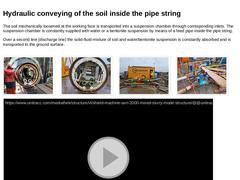
|
The soil mechanically loosened at the working face is transported into a suspension chamber through corresponding inlets. The suspension chamber is constantly supplied with water or a bentonite suspension by means of a feed pipe inside the pipe string. Over a second line (discharge line) the solid-fluid-mixture of soil and water/bentonite suspension is constantly absorbed and is transported to the ground surface. (Image: Hydraulic soil conveying) (… |

|
(Image: Technical components in pipe jacking - separation plant) Separation plants:
In all cases where flushing is based on bentonite, it is necessary to utilize a separation plant for cleaning and reclaiming the bentonite suspension and dewatering the spoil in order to make it fit for disposal. |
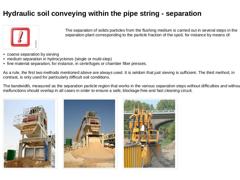
|

The separation of solids particles from the flushing medium is carried out in several steps in the separation plant corresponding to the particle fraction of the spoil, for instance by means of: -
coarse separation by sieving
-
medium separation in hydrocyclones (single or multi-step)
-
fine material separation, for instance, in centrifuges or chamber filter presses.
As a rule, the first two methods mentioned above are always used. … |

|
|
Separation plant:
Installation for the mechanical separation of the components solid (spoil) and liquid (liquid drilling fluid) in order to provide the drilling fluid again for the conveying circuit and to make the gained spoil disposable. The separation of solid particles from the drilling fluid is carried out by sedimentation techniques or multistage separation techniques corresponding to the in-situ particle fractions of the soil (based on [… |
|
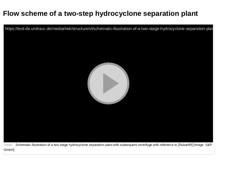
|
(Video: Schematic illustration of a two-stage hydrocyclone separation plant with subsequent centrifuge) |
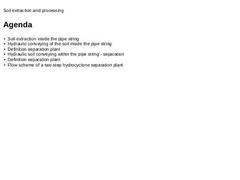
|

|
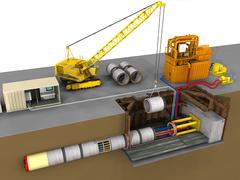
|
Today, the installation of gas, water and wastewater pipelines is still predominantly carried out using open trenches. In view of the numerous disadvantages associated with this method, it is imperative that trenchless pipeline construction be considered much more strongly in the future than it has been to date as an alternative in the planning and construction of sewers and pipelines.
This module deals in detail with the procedure and the various components. Emphasis is placed on the different types of shield machines, excavation tools, separation systems, the control and steering station, injection/grouting agent and soil extraction and reprocessing.
After completing this module, you will have a sound knowledge of:
- all components of pipe jacking and
- their function and tasks.
|
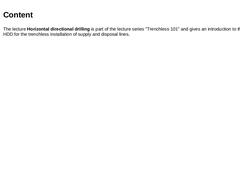
|

The lecture Horizontal directional drilling is part of the lecture series "Trenchless 101" and gives an introduction to the topic of HDD for the trenchless installation of supply and disposal lines. |
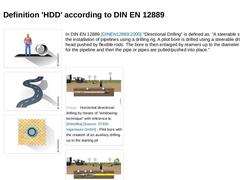
|

| (Image: Unmanned techniques) | | (Image: Steerable techniques) | | (Image: Soil removal techniques) |
| In DIN EN 12889 [DINEN12889:2000] "Directional Drilling" is defined as: "A steerable system for the installation of pipelines using a drilling rig. A pilot bore is drilled using a steerable drilling head pushed by flexible rods. The bore is then enlarged by reamers up to the diameter required for the pipeline and then the pipe or pipes are pulled/pushed … |
|
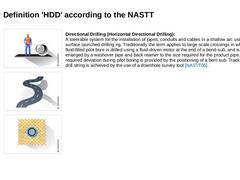
|

|
(Image: Unmanned techniques)
|
|
(Image: Steerable techniques)
|
|
(Image: Soil removal techniques)
|
|
Directional Drilling (Horizontal Directional Drilling):
A steerable system for the installation of pipes, conduits and cables in a shallow arc using a surface launched drilling rig. Traditionally the term applies to large scale crossings in which a fluid-filled pilot bore is drilled using a fluid-driven motor at the end of a bend-sub, and is then enlarged … |
|

|

|

|

| (Image: Add-on systems - Mini drill rig (CASE 300 CM) with 56 kN pulling force mounted to a compact loader [FI-Case])
|
Usually, horizontal directional drilling requires no starting and target shafts but merely starting and target pits at the entry and exit point of the drilling for catching the flushing fluid and the spoil. | | (Image: Mega boring rig at construction site [FI-Herreb])
| (Image: Drill rig at construction site [FI-Vermea])
|
|

|

(Image: Construction site arrangement when using a mega drill rig with reference to [DCA95] [Image: S&P GmbH] - Construction site arrangement at the exit point (pipe site)) The dimension of the drill rig, type and outer diameter of the line to be installed, the boring length and the pulling.in method significantly define the requirements concerning the required space, the accessibility and the equipment on the construction site arrangement. In general … |

|

|
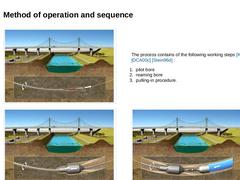
|

| (Image: Working steps for horizontal directional drilling (underground crossing of a river) with reference to [DCA01] [Image: S&P GmbH] - Pilot bore)
|
The process contains of the following working steps [Kleis96a] [DCA00c] [Stein96d] : - pilot bore
- reaming bore
- pulling-in procedure.
| | (Image: Working steps for horizontal directional drilling (underground crossing of a river) with reference to [DCA01] [Image: S&P GmbH] - Reaming bore)
| (Image: Working … |
|
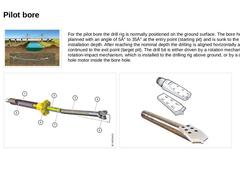
|

| (Image: Working steps for horizontal directional drilling (underground crossing of a river) with reference to [DCA01] [Image: S&P GmbH] - Pilot bore)
For the pilot bore the drill rig is normally positioned on the ground surface. The bore hole is planned with an angle of 5° to 35° at the entry point (starting pit) and is sunk to the planned installation depth. After reaching the nominal depth the drilling is aligned horizontally and is continued … |
|
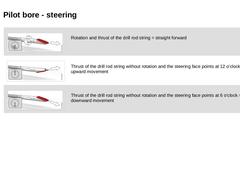
|

| | (Image: Rotation and thrust of the drill rod string = straight forward)
Rotation and thrust of the drill rod string = straight forward | | (Image: Thrust of the drill rod string without rotation and the steering face points at 12 o'clock = upward movement)
Thrust of the drill rod string without rotation and the steering face points at 12 o'clock = upward movement | | (Image: Thrust of the drill rod string without rotation and the steering face points at … |
|
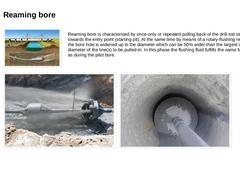
|

| (Image: Working steps for horizontal directional drilling (underground crossing of a river) with reference to [DCA01] [Image: S&P GmbH] - Reaming bore)
Reaming bore is characterised by once-only or repeated pulling back of the drill rod string towards the entry point (starting pit). At the same time by means of a rotary-flushing reamer the bore hole is widened up to the diameter which can be 50% wider than the largest outer diameter of the line(… |
|
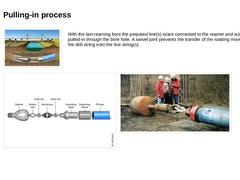
|

| (Image: Working steps for horizontal directional drilling (underground crossing of a river) with reference to [DCA01] [Image: S&P GmbH] - Pulling-in process)
With the last reaming bore the prepared line(s) is/are connected to the reamer and is/are pulled-in through the bore hole. A swivel joint prevents the transfer of the rotating movement of the drill string onto the line string(s). | |
(Image: Structure and view of an expanding pulling head (without … |
|
|
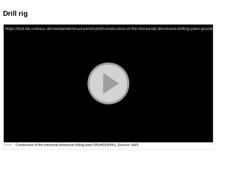
|

(Video: Construction of the horizontal directional drilling plant GRUNDODRILL) |
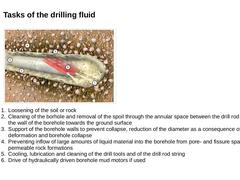
|

| (Image: Tasks of the drilling fluid)
| - Loosening of the soil or rock
- Cleaning of the borhole and removal of the spoil through the annular space between the drill rod and the wall of the borehole towards the ground surface
- Support of the borehole walls to prevent collapse, reduction of the diameter as a consequence of plastic deformation and borehole collapse
- Preventing inflow of large amounts of liquid material into the borehole from pore- and fissure …
|
|
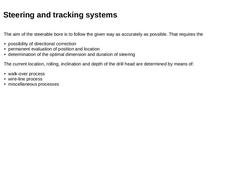
|

|
The aim of the steerable bore is to follow the given way as accurately as possible. That requires the - possibility of directional correction
- permanent evaluation of position and location
- determination of the optimal dimension and duration of steering
The current location, rolling, inclination and depth of the drill head are determined by means of: - walk-over process
- wire-line process
- miscellaneous processes
|
|
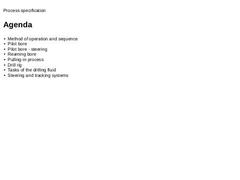
|

|
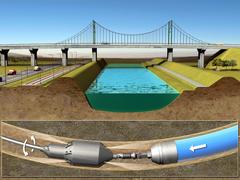
|

This lecture is part of the series "Trenchless 101" and serves to provide an overview of horizontal directional drilling (HDD). |